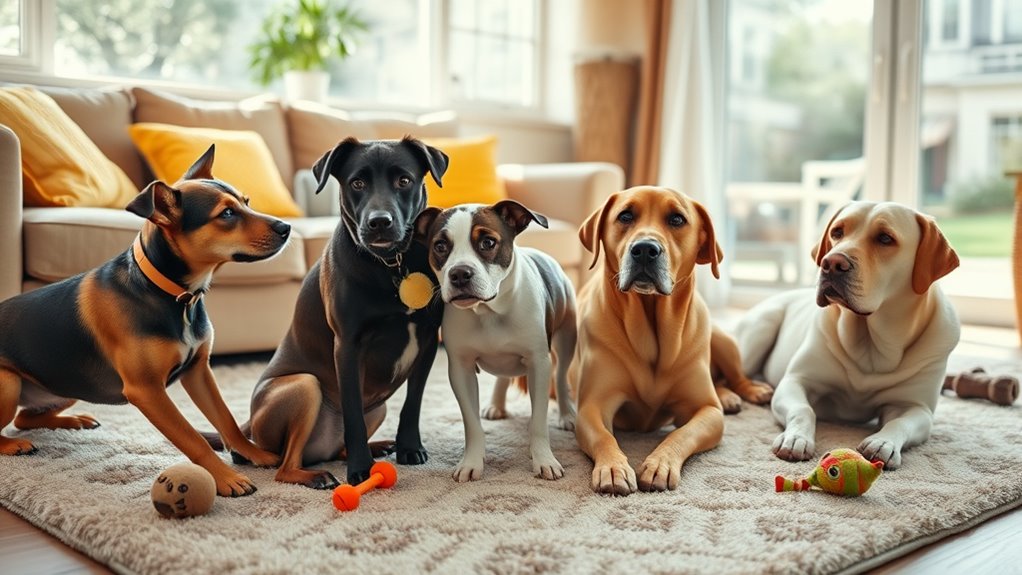To manage multi-dog household dynamics, set consistent routines, boundaries, and rules for all dogs. Understand each dog’s personality and body language to prevent conflicts, and provide separate spaces for privacy and rest. Manage resources like toys and food to avoid jealousy and monitor for early signs of fights. Encourage positive socialization and calm interactions, and stay alert to behavioral changes. Keep things balanced, and you’ll find that harmony and peace can become the norm as you learn more.
Key Takeaways
- Establish consistent rules, routines, and boundaries to promote harmony and reduce conflicts among dogs.
- Provide individual personal spaces and designated areas to minimize territorial disputes and stress.
- Distribute resources like food, toys, and attention evenly to prevent possessiveness and jealousy.
- Use positive reinforcement and supervised socialization to encourage respectful interactions and appropriate behaviors.
- Recognize early signs of conflicts and address them promptly to maintain household peace and canine well-being.
Understanding Canine Personalities and Temperaments
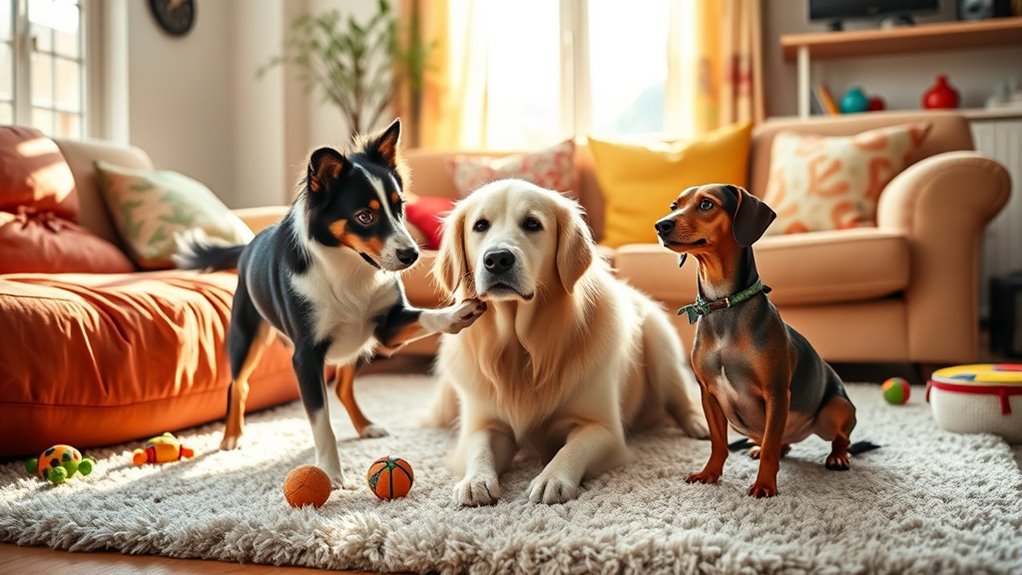
Understanding your dogs’ personalities and temperaments is essential for managing a multi-dog household effectively. Recognizing how your dogs communicate through canine communication cues helps you interpret their signals and prevent misunderstandings. Each dog’s breed influences its behavior, making breed compatibility a key factor in pairing dogs. Some breeds are naturally more social and tolerant, while others may be more territorial or reserved. Observing how your dogs interact, play, and respond to different situations reveals their individual temperaments. By understanding these differences, you can create a harmonious environment where each dog feels safe and respected. Additionally, understanding canine communication cues can help you better respond to your dogs’ needs and prevent potential issues before they escalate. Recognizing breed-specific traits, such as the sociability of Labradoodles or the independence of Huskies, can also aid in understanding dog behavior patterns, which are often influenced by breed tendencies. Being aware of canine body language is crucial for accurately interpreting your dogs’ feelings and reactions.
Establishing Clear Boundaries and Rules
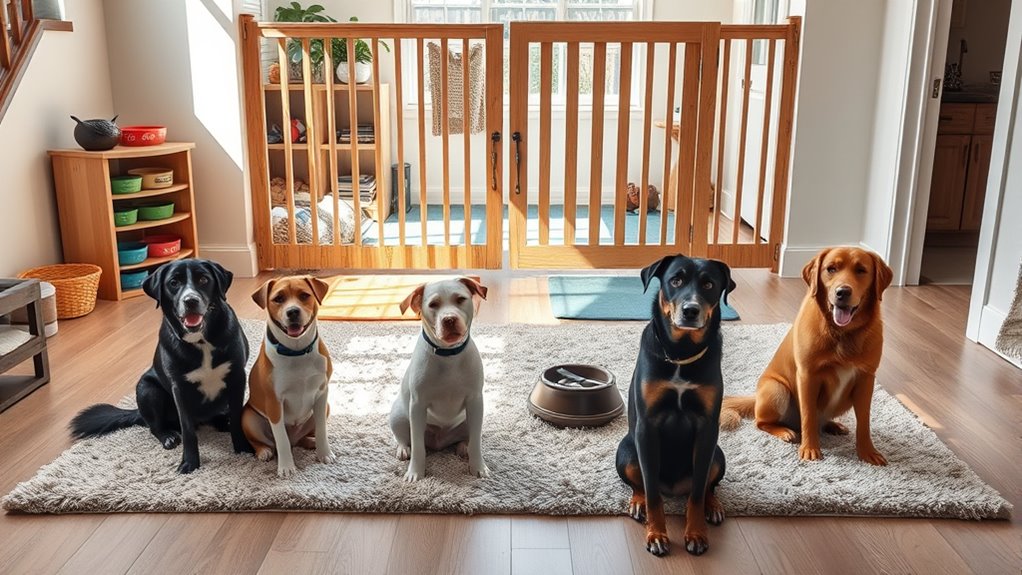
Establishing clear boundaries and rules is essential for maintaining harmony in a multi-dog household. Consistent guidelines help prevent conflicts and guarantee everyone knows what’s expected. To do this effectively:
Clear boundaries and rules ensure harmony and prevent conflicts in a multi-dog home.
- Set rules for dog park etiquette, like waiting your turn and respecting others’ space.
- Enforce leash manners during walks, such as no pulling or jumping.
- Define designated areas for play and rest to reduce territorial disputes.
- Teach commands consistently across all dogs to promote obedience and cooperation.
- Incorporate automation technologies to monitor and manage multiple dogs more effectively, ensuring safety and adherence to household rules. Additionally, understanding family dynamics can help tailor training approaches to suit individual dogs’ needs and personalities. Implementing behavioral monitoring systems can provide real-time insights into each dog’s activities and help reinforce boundaries more efficiently.
Creating a Consistent Routine for All Dogs
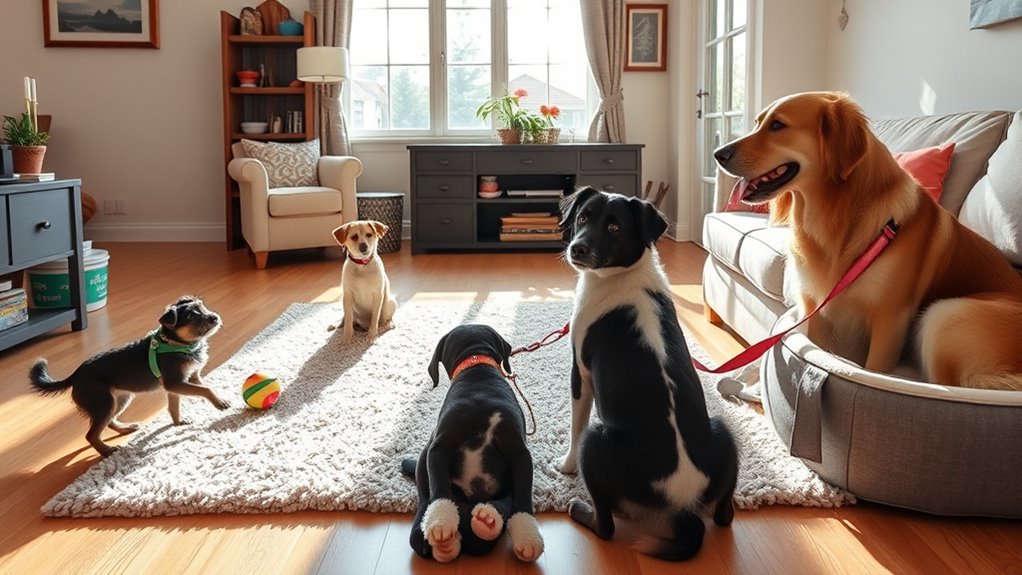
A consistent routine helps all your dogs feel secure and understand what to expect each day. Start by feeding them at regular times and scheduling exercise sessions that suit everyone’s needs. Incorporate unified training sessions to reinforce rules and promote harmony among your dogs. Using mindfulness techniques can also help in establishing a structured environment that benefits multi-dog households. Additionally, selecting vet-approved products can ensure your dogs are receiving safe and effective care as part of your routine.
Regular Feeding Schedule
Creating a consistent feeding schedule is essential for maintaining harmony in a multi-dog household. When you stick to specific times, each dog knows when to expect their meal, reducing anxiety and competition. To guarantee smooth meals:
- Use separate feeding bowls for each dog to prevent food guarding.
- Serve a consistent amount of food at each sitting to avoid overeating or hunger.
- Incorporate meal variety by rotating protein sources or treats to keep their interest.
- Stick to scheduled feeding times daily, even on weekends, for routine stability.
This routine helps each dog develop good eating habits and minimizes conflicts. By maintaining a predictable schedule, you make feeding times more peaceful and enjoyable for everyone.
Consistent Exercise Times
Maintaining a consistent exercise routine for all your dogs helps reinforce structure and predictability in their daily lives. By establishing set times for playtime routines and exercise, you reduce chaos and help your dogs feel secure. Consistent exercise timing also prevents overexertion and ensures each dog gets enough activity. To keep things organized, consider this schedule:
| Time | Activity | Duration |
|---|---|---|
| 7:00 AM | Morning walk | 30 mins |
| 12:00 PM | Playtime indoors | 20 mins |
| 4:00 PM | Afternoon walk | 30 mins |
| Evening | Relax & light play | 15 mins |
Stick to this routine daily to foster calmness, improve behavior, and strengthen your dogs’ bond through consistent exercise timing and playtime routines. Establishing a structured routine also helps manage multiple dogs more effectively. Additionally, monitoring water requirements during outdoor activities ensures your dogs stay properly hydrated and healthy. Incorporating long-term planning into your routine can further promote overall well-being for your dogs. Regularly checking the return policies of local pet stores or services can also help you plan for any necessary equipment or supplies replacements.
Unified Training Sessions
Implementing unified training sessions helps establish a consistent routine for all your dogs, making training more efficient and effective. During these sessions, you can focus on reinforcing the dog social hierarchy and ensuring each dog understands their role. To maximize success:
- Keep sessions short and focused to prevent boredom.
- Use positive reinforcement to encourage good behavior.
- Incorporate grooming routines into training to promote hygiene and familiarity.
- Practice commands with all dogs together, emphasizing leadership and respect.
- Pay attention to visual cues to ensure clear and effective communication between you and your dogs. Proper tuning techniques, as seen in automotive maintenance, can be a useful analogy for adjusting your training approach to fit your dogs’ needs. Additionally, understanding behavioral signals helps you interpret your dogs’ responses and adapt your training accordingly.
This approach helps create a harmonious environment, reducing conflicts and confusion. Consistent training not only reinforces boundaries but also strengthens your bond with each dog. Over time, your dogs will better understand their place in the social hierarchy, making daily interactions smoother.
Designing Separate Spaces for Privacy and Rest
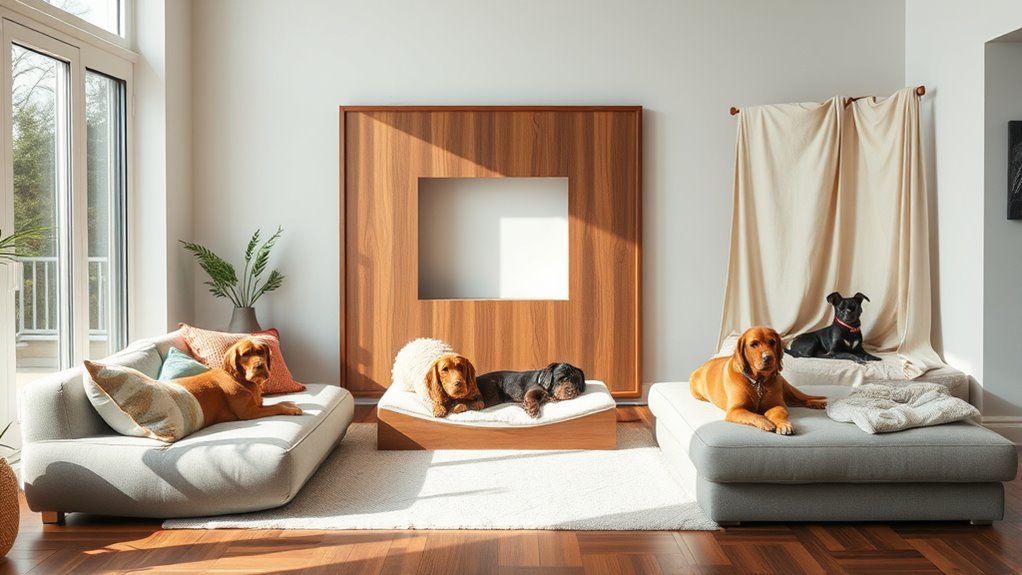
To guarantee each dog has a safe haven for privacy and rest, you should design separate spaces within your home. Create a cozy corner or a dedicated doggy den where each dog can retreat comfortably. These spaces should be quiet, away from high-traffic areas, and equipped with soft bedding. Consider placing their den in a corner or under a piece of furniture to give a sense of security. Providing individual spaces helps prevent conflicts and reduces stress by giving each dog a personal sanctuary. Keep these areas clean and inviting, and encourage your dogs to use them regularly. Additionally, Self Watering Plant Pots can serve as a helpful analogy for creating dedicated, low-maintenance resting areas, ensuring your dogs’ needs are consistently met without frequent intervention. Being mindful of your dogs’ emotional well-being by providing distinct personal spaces can improve their overall behavior and happiness. Incorporating consistent routines for each dog around these spaces can further enhance their sense of security and comfort.
Managing Resources to Prevent Fights and Jealousy
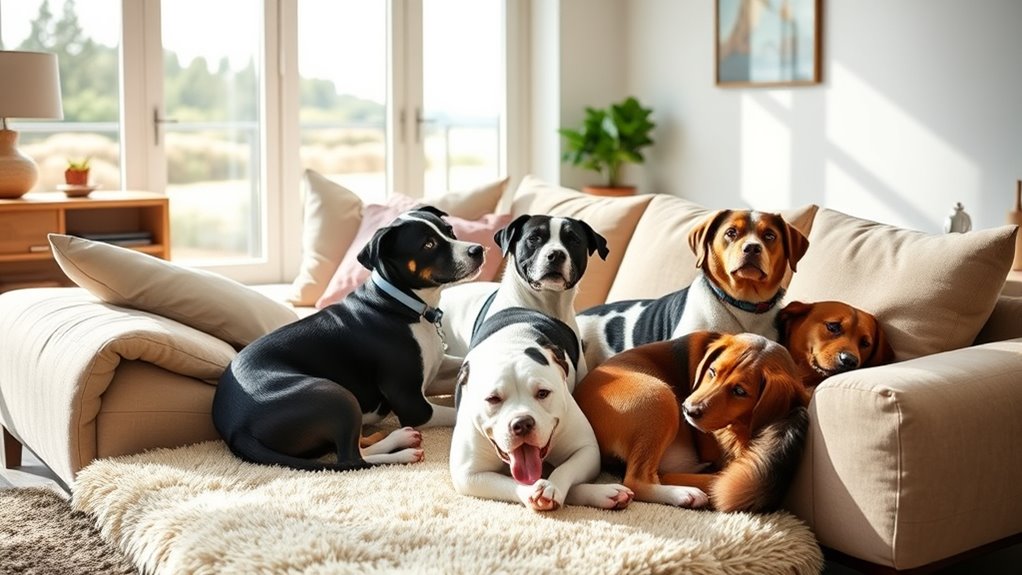
Since resource guarding can trigger fights and jealousy among dogs, managing their access to food, toys, and attention is essential. Proper resource allocation reduces competition and promotes harmony. To prevent jealousy, consider these steps:
- Distribute food and treats equally, giving each dog their own bowl and space.
- Rotate toys regularly to prevent possessiveness and ensure everyone has new items.
- Allocate individual attention, spending quality one-on-one time with each dog.
- Establish designated resting and sleeping areas to minimize territorial disputes.
- Understanding dog social behavior patterns can assist in managing interactions and preventing jealousy from escalating.
- Recognizing resource guarding tendencies can help in implementing effective management strategies to reduce conflicts.
Training Techniques for Multi-Dog Households
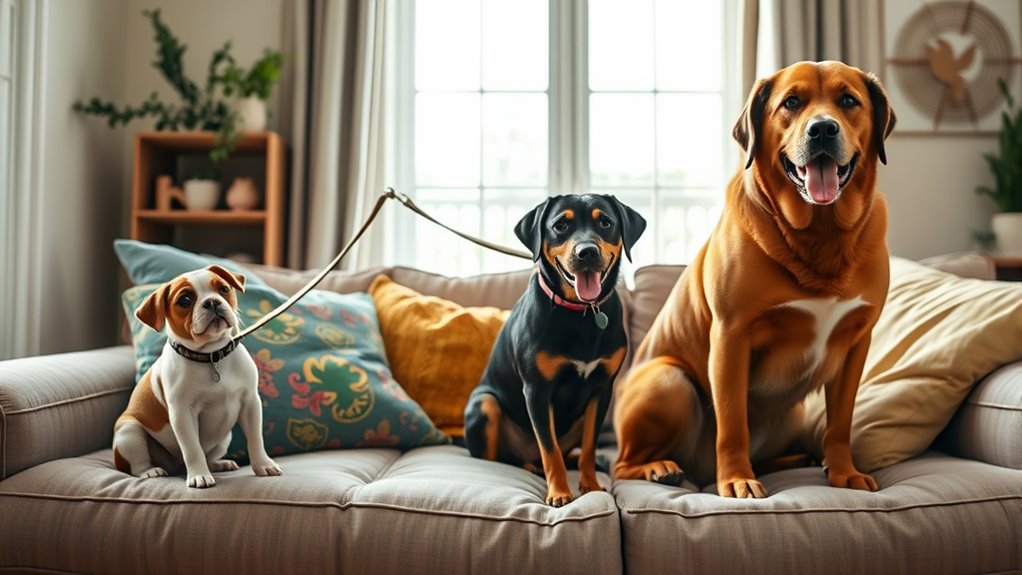
Effective training is key to fostering harmony in a multi-dog household, as it helps establish clear boundaries and consistent behavior expectations. Consistent commands and routines reinforce good behavior across all dogs. Incorporate positive reinforcement, like treats and praise, to encourage desired actions. Regular grooming sessions and proper canine nutrition support their well-being, making training easier. Use the following table to visualize household roles and routines:
| Dog 1 | Dog 2 | Dog 3 | Dog 4 |
|---|---|---|---|
| Sit | Stay | Leave it | Come |
| Grooming | Feeding | Exercise | Rest |
This structured approach ensures each dog understands its place, reducing conflicts and promoting cooperation. Remember, patience and consistency are your best tools for successful training in a multi-dog environment.
Recognizing and Addressing Conflicts Early
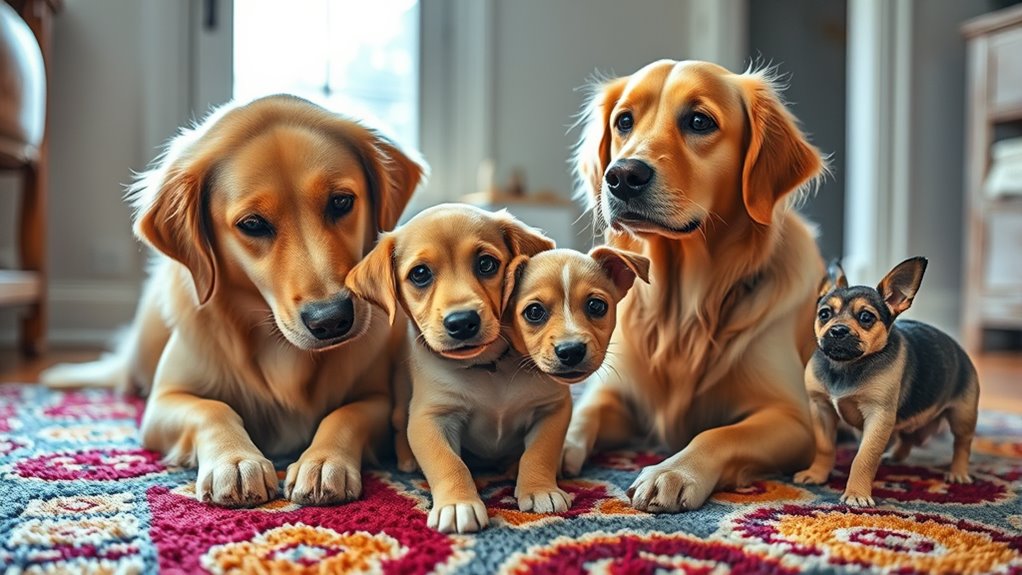
Consistently applying training techniques helps create a well-behaved multi-dog household, but even with clear routines, conflicts can still arise. Recognizing issues early prevents escalation. Keep an eye out for signs like growling, stiff body language, or avoidance. Address conflicts promptly by:
Early signs of conflict, like growling or stiff bodies, help prevent escalation and maintain harmony.
- Separating dogs calmly to prevent escalation.
- Observing their interactions during dog grooming or veterinary checkups.
- Reinforcing positive behaviors with treats and praise.
- Consulting a professional if conflicts persist or escalate.
Early intervention helps maintain harmony and ensures each dog feels safe. Regular veterinary checkups can reveal health issues that might trigger behavioral changes. Staying alert to early signs enables you to manage conflicts before they become serious, creating a peaceful multi-dog household.
Encouraging Positive Interactions and Socialization
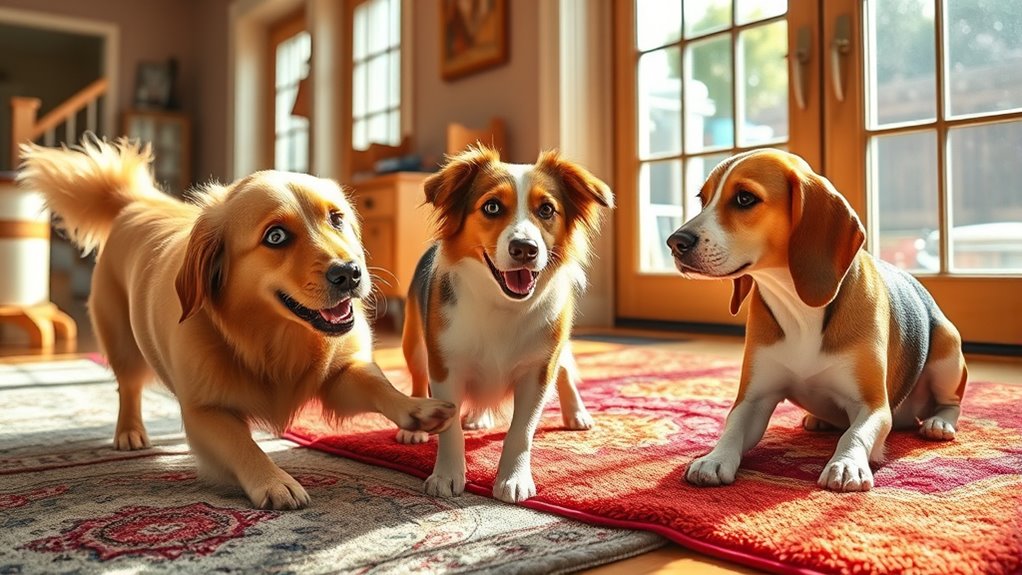
Creating a positive environment for your dogs starts with encouraging friendly interactions and proper socialization. When dogs greet each other, promote playful greetings that focus on calm, respectful behavior. Watch for social cues like wagging tails, relaxed postures, and open mouths, which signal comfort. Reinforce these signs with praise and gentle encouragement to build confidence and trust. Avoid forcing interactions; instead, let dogs approach at their own pace. Use supervised play sessions to facilitate positive exchanges, ensuring each dog feels safe. Consistent socialization helps your dogs learn appropriate behaviors and reduces anxiety around others. By fostering friendly greetings and understanding social cues, you create a harmonious atmosphere where your dogs can enjoy positive interactions and develop strong bonds.
Monitoring Health and Behavioral Changes
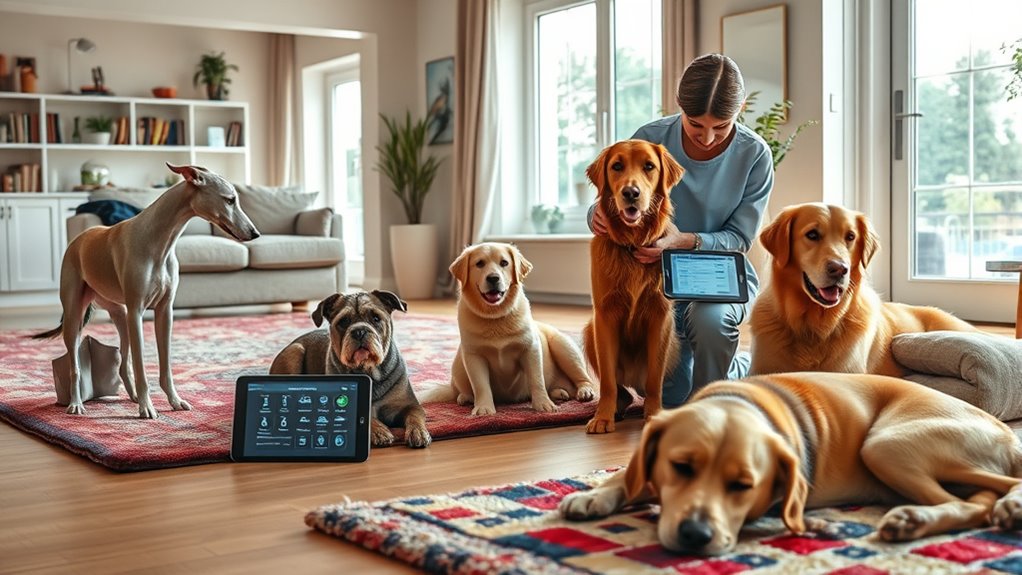
Keeping an eye on subtle changes in your dogs’ health and behavior helps catch issues early. Track shifts in their eating habits or activity levels, and watch for signs like limping or unusual vocalizations. Recognizing these clues allows you to address concerns before they worsen.
Spotting Subtle Changes
While your dogs may seem healthy and active most of the time, subtle changes in their behavior or physical condition can signal underlying issues. Pay close attention to:
- Sudden vocalizations that seem out of character, which could indicate discomfort or pain.
- Changes in subtle body language, like a tucked tail or stiff posture, signaling stress or illness.
- Reduced activity or reluctance to engage in usual routines.
- Increased grooming, licking, or scratching, hinting at skin issues or allergies.
Noticing these small signals early helps catch health problems before they escalate. Regularly observe how your dogs react to their environment and each other. Your keen eye can make a significant difference in their well-being.
Tracking Dietary Shifts
Monitoring your dogs’ diets helps you spot subtle health and behavior changes that might otherwise go unnoticed. Keep a close eye on their food intake, noting any shifts in appetite or preferences, especially when introducing dietary supplementation. Changes in eating habits can signal nutritional imbalances or underlying health issues. Tracking these shifts allows you to adjust portions or ingredients to maintain a balanced diet. Guarantee each dog receives the proper nutritional balance tailored to their age, size, and health needs. By paying attention to small variations in their diet, you can identify early signs of issues and make informed adjustments. This proactive approach supports overall well-being and helps prevent more serious problems down the line.
Recognizing Behavioral Signs
Recognizing behavioral signs is essential for catching health issues early in a multi-dog household. By observing dog communication and canine body language, you can spot changes that signal discomfort or illness. Keep an eye on these key signs:
- Sudden changes in activity levels or energy
- Unusual postures or facial expressions indicating pain
- Withdrawal from play or social interactions
- Altered eating, drinking, or bathroom habits
Understanding subtle cues helps you respond promptly. For example, a dog avoiding eye contact or leaning away may signal stress or pain. Monitoring these behavioral signs allows you to differentiate between normal behavior and potential health concerns, ensuring timely veterinary care and maintaining harmony among your dogs.
Building a Harmonious Household Environment
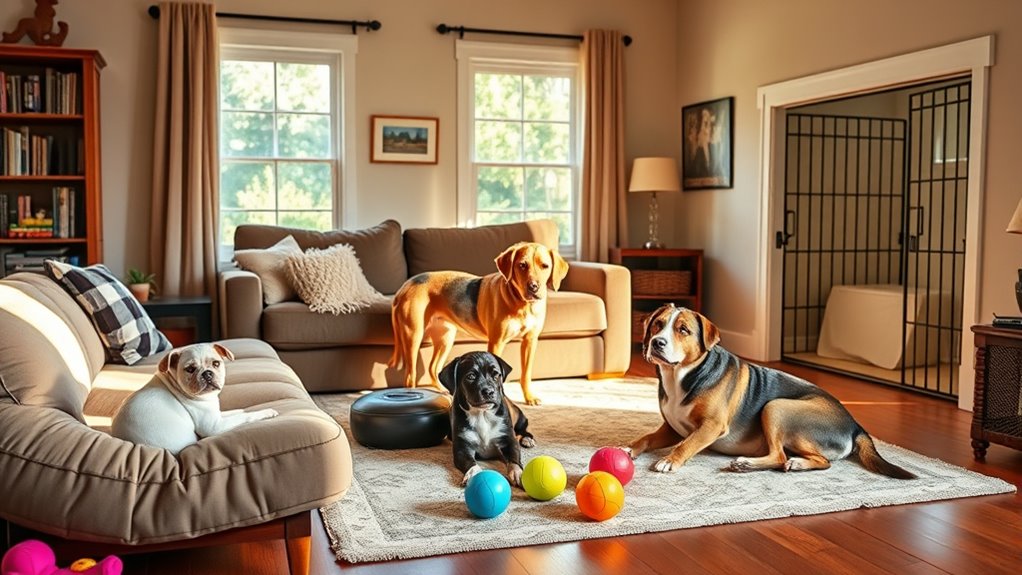
Creating a harmonious household environment starts with establishing clear routines and consistent rules that all your dogs understand. Consistency helps reduce confusion and conflicts, making everyone feel secure. Incorporate proper dog park etiquette by teaching your dogs how to behave politely around other dogs, which minimizes stress during outings. Regular grooming routines not only keep your dogs clean and healthy but also serve as bonding time, reinforcing positive interactions. Guarantee all dogs follow the same rules, like waiting patiently for treats or respecting each other’s space. By maintaining predictable routines and reinforcing good manners, you help foster mutual respect and reduce jealousy or competition. A calm, structured environment allows your dogs to coexist peacefully and enjoy a balanced, happy household.
Frequently Asked Questions
How Do I Introduce a New Dog to My Existing Household?
When introducing a new dog, you should start with a controlled dog introduction in a neutral space. Use scent swapping by exchanging bedding or toys to familiarize them with each other’s smell. Keep the initial meeting calm and positive, allowing them to observe and approach at their own pace. Gradually increase their time together, always supervising, until you’re confident they’re comfortable. This approach helps guarantee a smooth, safe integration into your household.
What Are Signs of Stress or Anxiety in Multi-Dog Homes?
You notice signs of stress or anxiety in your dogs through their body language and vocalizations. Look for tucked tails, pinned-back ears, yawning, lip licking, or avoiding eye contact. Increased canine vocalizations, like whining, barking, or growling, also indicate discomfort. You might see tension or agitation, especially when they’re near each other. Recognizing these signs helps you intervene early, reducing stress and fostering a more harmonious household.
How Can I Prevent Resource Guarding Among Dogs?
To prevent resource guarding among your dogs, establish proper feeding routines by feeding them separately or in designated zones. This helps prevent competition and reduces possessiveness. Encourage safe toy sharing by supervising playtime and offering shared toys that multiple dogs can enjoy together. Consistently reinforce positive behavior, reward sharing, and avoid punishing guarding behaviors. With patience and consistency, you’ll foster a calm environment where your dogs feel secure and less prone to guarding resources.
What Should I Do if Dogs Show Aggressive Behavior?
Imagine tension hanging in the air, your dogs’ body language revealing warning signs. When aggression surfaces, stay calm and observe closely. Use calming techniques like gentle voice commands or redirect their focus. Watch for signals like raised hackles or stiff posture. If needed, calmly separate them to prevent escalation. Your steady presence and understanding of their body language help defuse the situation, keeping everyone safe and restoring peace.
How Do I Manage Differing Energy Levels Among My Dogs?
To manage differing energy levels among your dogs, observe each dog’s activity needs and tailor their routines accordingly. Use calming techniques like gentle petting or quiet time for high-energy dogs to help them relax. For lower-energy dogs, provide engaging activities to keep them stimulated. Matching activities to each dog’s energy level guarantees everyone stays balanced and happy, reducing stress and promoting harmony in your household.
Conclusion
By understanding your dogs’ personalities and setting clear boundaries, you create a peaceful home. Think of it like tending a garden—you nurture harmony by giving each dog space to grow and flourish. When conflicts arise, address them early, just as you weed out the weeds before they take over. With patience and consistency, your multi-dog household can blossom into a joyful, balanced family where everyone feels safe, loved, and respected.

